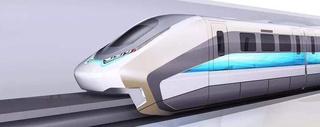Magrail: The Brilliant Mix of Maglev and Traditional Rail
The Warsaw-based Hyper Poland is promising to deliver a new type of train, a hybrid of traditional rail and maglev that can use the existing rail infrastructure. The advantage of this makes it possible to upgrade existing rail lines without the need of building a completely new infrastructure that is required for maglev technology. The company has experts who have previously worked with Airbus, Bombardier, and the Japanese Shinkansen. The end goal is to create hyperloop-inspired transportation. The are three-stages in the implementation plan.
Phase 1. - Magrail
Upgrading the existing rails with hardware that allows for high-speed and high-frequency travel. This is achieved by using passive magnetic levitation technology, the conventional rails are upgraded with levitation plates mounted on the sides of the track. The solution allows magrail to use the same transportation corridors as conventional trains. Hyper Poland suggests that it would take them around 5 to 8 years from development until realization. Initially, the trains are planned to transport cargo.
Speed: 186 mph (300kph) on conventional tracks, 415 km/h (257 mph) on HSR lines

Phase 2. - Hyperrail
The second stage of the implementation involves the construction of special vacuum covers that allow higher speeds.
Speed: 600 km/h (373 mph) on existing conventional tracks, 1,000 km/h (621 mph) on HSR lines

Phase 3. - Hyperloop
The final stage – Elon Musk's dream – is the so-called hyperloop that would run on a dedicated track. The transformation would allow the trains to reach higher speeds than airplanes, minimizing travel times and enabling trains to directly compete with the aviation industry.
Speed: 1,200 km/h (746 mph)

How energy efficient is magrail?
Hyper Poland claims 93 Wh/seat-km at 300 km/h. A recent publication by The International Maglev Board calculated 59 Wh/seat-km at 330 km/h for Intercity-Express 3 operated by Deutsche Bahn and 45 Wh/seat-km at 330 km/h for Transrapid maglev operated by Shanghai Maglev Transportation Development Co. Ltd. As the numbers can differ based on the number of seats and various factors we would abstain from making a conclusion based on this data alone.

What is passive levitation?
Current maglev systems used by SCMaglev (Japan), CRRC (China), Transrapid (Germany) are using active levitation which means that the electromagnets both in the train and the track are supplied by energy. In the case of passive levitation, the levitating-effect is achieved by speed. The train will lift off the ground at a certain speed and start levitating.

How much is it going to cost?
The first phase, which is upgrading the existing railway tracks estimated to cost between €6-8 million / km. This is about 5 to 8 times cheaper than building maglev infrastructure.

What is the current status?
Hyper Poland started working on this project in 2015. In October 2019, the company successfully demonstrated the passive levitation technology on a 1:5 scale model, that ran on a 48-meter test track.





